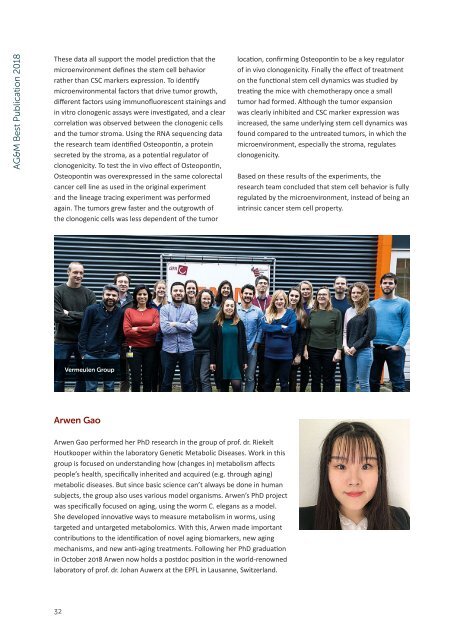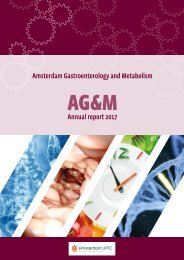AG&M annual report 2018
Create successful ePaper yourself
Turn your PDF publications into a flip-book with our unique Google optimized e-Paper software.
AG&M Best Publication <strong>2018</strong><br />
These data all support the model prediction that the<br />
microenvironment defines the stem cell behavior<br />
rather than CSC markers expression. To identify<br />
microenvironmental factors that drive tumor growth,<br />
different factors using immunofluorescent stainings and<br />
in vitro clonogenic assays were investigated, and a clear<br />
correlation was observed between the clonogenic cells<br />
and the tumor stroma. Using the RNA sequencing data<br />
the research team identified Osteopontin, a protein<br />
secreted by the stroma, as a potential regulator of<br />
clonogenicity. To test the in vivo effect of Osteopontin,<br />
Osteopontin was overexpressed in the same colorectal<br />
cancer cell line as used in the original experiment<br />
and the lineage tracing experiment was performed<br />
again. The tumors grew faster and the outgrowth of<br />
the clonogenic cells was less dependent of the tumor<br />
location, confirming Osteopontin to be a key regulator<br />
of in vivo clonogenicity. Finally the effect of treatment<br />
on the functional stem cell dynamics was studied by<br />
treating the mice with chemotherapy once a small<br />
tumor had formed. Although the tumor expansion<br />
was clearly inhibited and CSC marker expression was<br />
increased, the same underlying stem cell dynamics was<br />
found compared to the untreated tumors, in which the<br />
microenvironment, especially the stroma, regulates<br />
clonogenicity.<br />
Based on these results of the experiments, the<br />
research team concluded that stem cell behavior is fully<br />
regulated by the microenvironment, instead of being an<br />
intrinsic cancer stem cell property.<br />
Vermeulen Group<br />
Arwen Gao<br />
Arwen Gao performed her PhD research in the group of prof. dr. Riekelt<br />
Houtkooper within the laboratory Genetic Metabolic Diseases. Work in this<br />
group is focused on understanding how (changes in) metabolism affects<br />
people’s health, specifically inherited and acquired (e.g. through aging)<br />
metabolic diseases. But since basic science can’t always be done in human<br />
subjects, the group also uses various model organisms. Arwen’s PhD project<br />
was specifically focused on aging, using the worm C. elegans as a model.<br />
She developed innovative ways to measure metabolism in worms, using<br />
targeted and untargeted metabolomics. With this, Arwen made important<br />
contributions to the identification of novel aging biomarkers, new aging<br />
mechanisms, and new anti-aging treatments. Following her PhD graduation<br />
in October <strong>2018</strong> Arwen now holds a postdoc position in the world-renowned<br />
laboratory of prof. dr. Johan Auwerx at the EPFL in Lausanne, Switzerland.<br />
32



